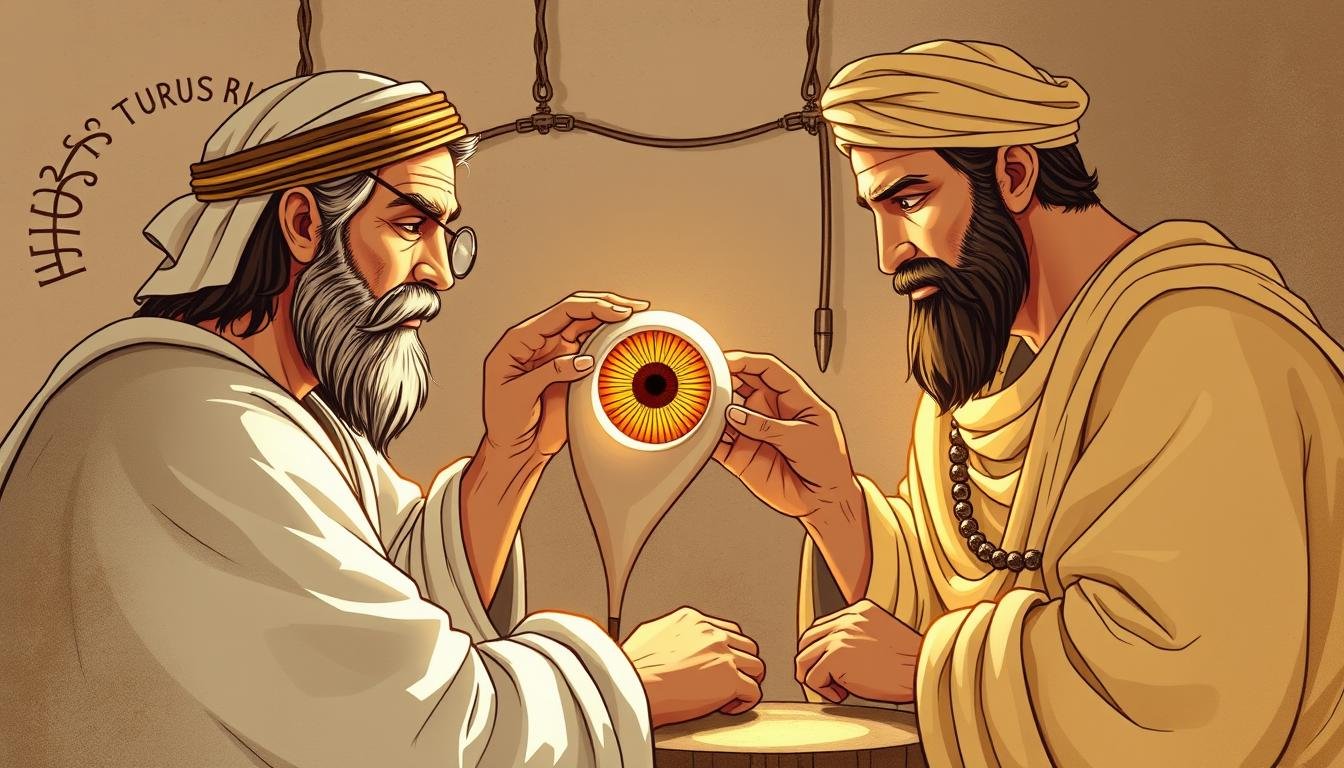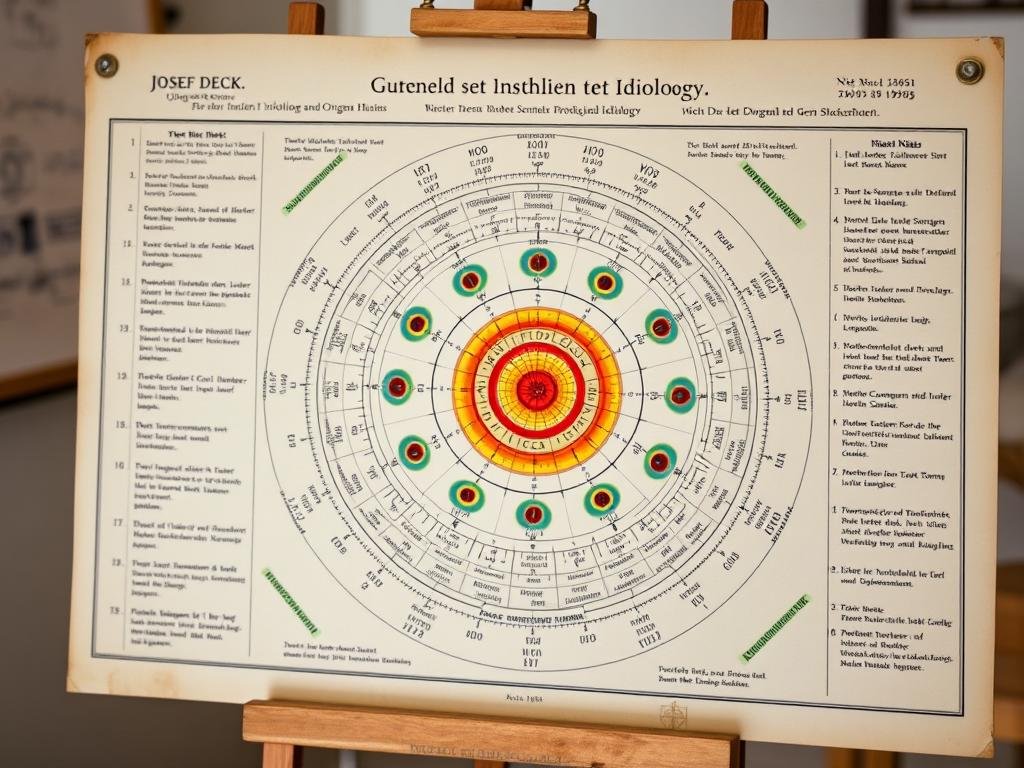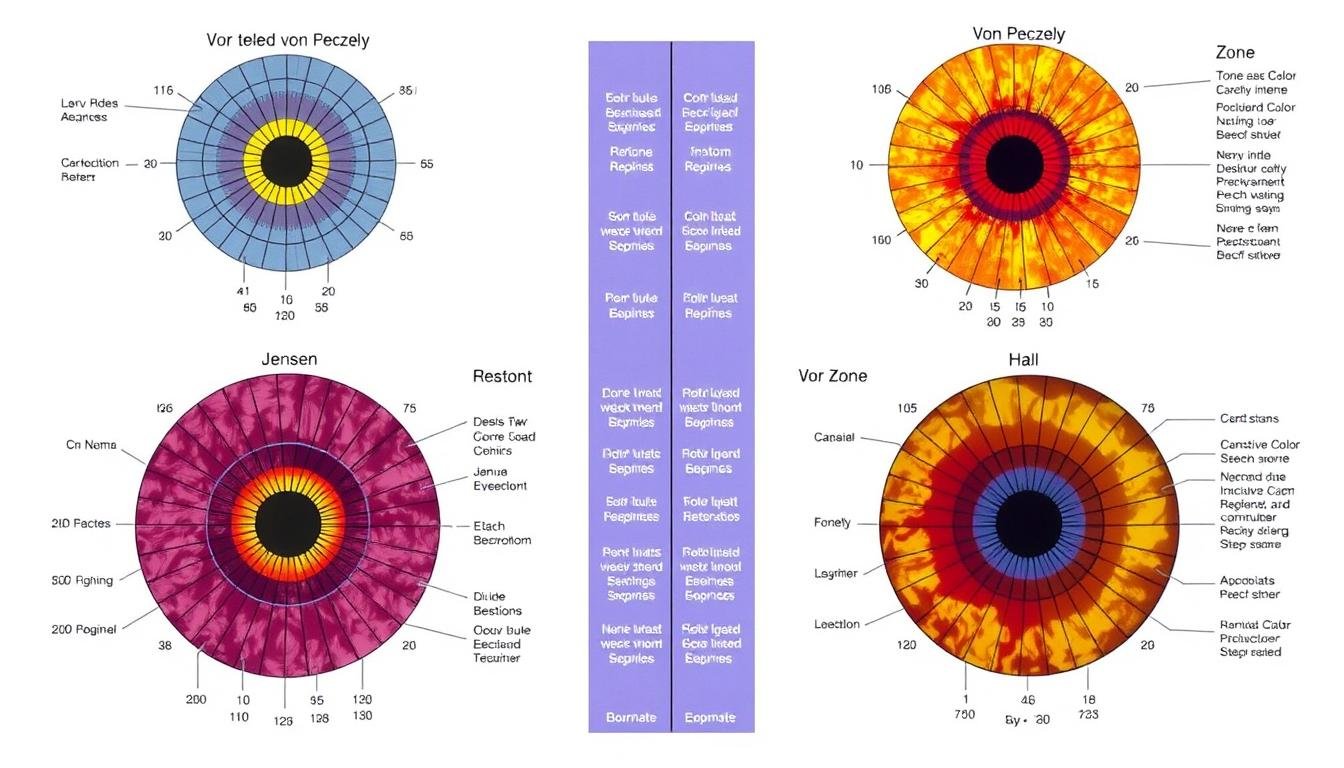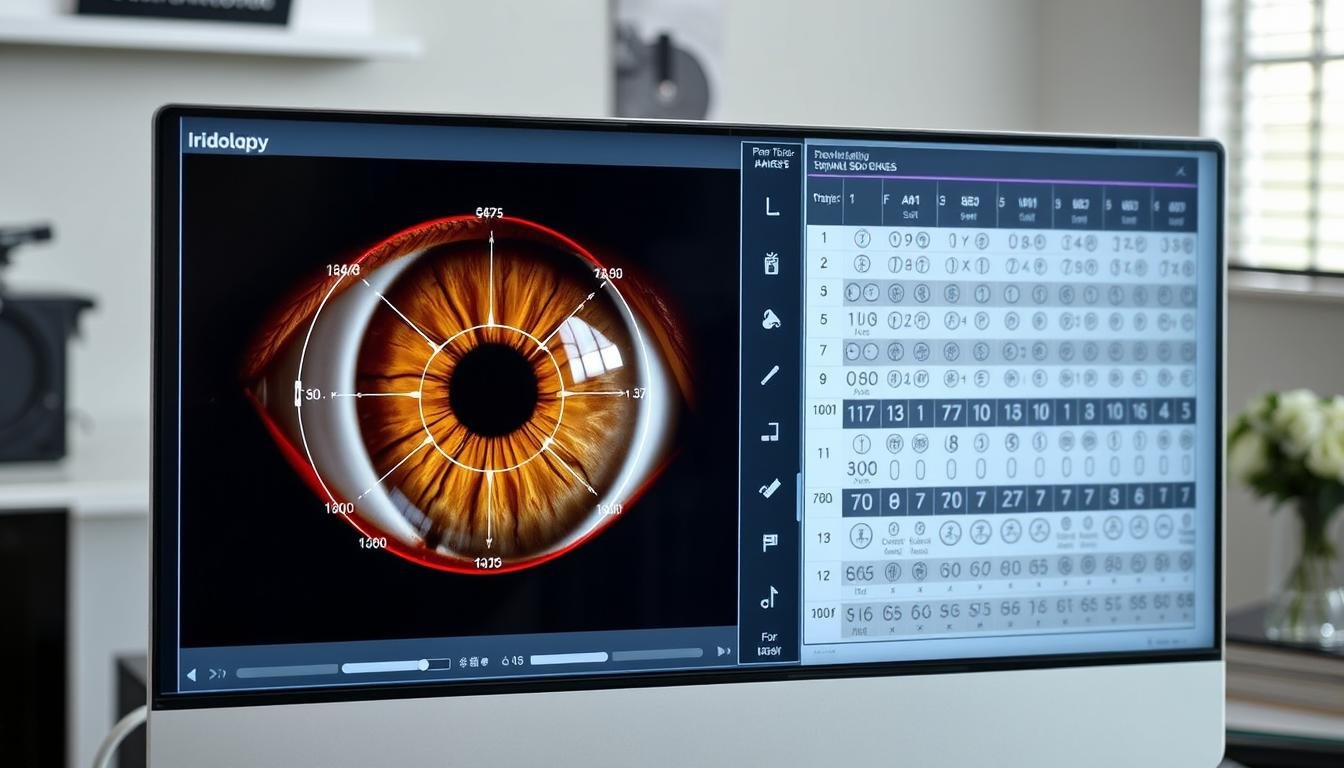The fascinating field of iridology has evolved through the dedicated work of pioneering practitioners who developed sophisticated Iridologie-Diagramme for analyzing the iris. These visionaries established the foundation for modern iris analysis by mapping connections between iris markings and physical health. Their groundbreaking work continues to influence holistic health practitioners worldwide, offering insights into potential health concerns through non-invasive examination of the colored part of the eye.

The Historical Origins of the Iridologie-Diagramm
The practice of examining the iris for health insights dates back thousands of years, with early references found in ancient Chinese and Egyptian texts. However, the systematic development of the Iridologie-Diagramm as we know it today began in the 19th century with several key figures who transformed these ancient observations into a structured diagnostic approach.
Early practitioners examining the iris patterns, laying groundwork for modern Iridologie-Diagramme
Before the development of standardized charts, practitioners relied on individual observations without systematic reference points. The creation of the first comprehensive Iridologie-Diagramm marked a turning point, establishing a methodical approach to iris analysis that could be taught, learned, and refined by subsequent generations of practitioners.
Ignaz von Peczely: Father of Modern Iridologische Diagramme

Ignaz von Peczely with his revolutionary Iridologie-Diagramm ab 1881
The story of modern iridology begins with Hungarian physician Ignaz von Peczely (1826-1911), widely recognized as the father of contemporary iridology. As a child, von Peczely reportedly noticed changes in an owl’s iris after the bird suffered a broken leg. This observation sparked his lifelong interest in the connection between iris markings and physical trauma or disease.
1881 veröffentlichte von Peczely sein bahnbrechendes Werk “Entdeckungen auf dem Gebiet der Naturwissenschaften und der Medizin: Anleitung zum Studium der Augendiagnose,” die die ersten detaillierten enthielt Iridologie-Diagramm. His chart divided the iris into approximately 80 zones, each corresponding to different organs and systems within the body.
Von Peczely’s Contribution to Iridologie-Diagramm Entwicklung
- Created the first systematic mapping of iris zones to body organs
- Established the foundational principles for modern iris analysis
- Documented correlations between iris markings and specific health conditions
- Developed a diagnostic methodology that could be taught to other practitioners
Von Peczely’s work established the fundamental principle that the iris could serve as a diagnostic map of the entire body, with specific areas corresponding to particular organs and systems. This concept remains central to all subsequent Iridologie-Diagramme.
Nils Liljequist: The Swedish Contribution to Iridologische Diagramme

Nils Liljequist developed his Iridologie-Diagramm independently of von Peczely
Working independently of von Peczely, Swedish homeopath Nils Liljequist (1851-1936) developed his own Iridologie-Diagramm based on personal observations. After suffering mercury poisoning from medical treatments, Liljequist noticed changes in his own iris coloration and began documenting these changes in relation to his health.
His 1893 publication “Über die Augendiagnose” (On Eye Diagnosis) included detailed iris charts that emphasized the importance of color changes in the iris as indicators of chemical toxicity in the body. Liljequist’s work was particularly significant for identifying how medications and toxins could manifest as specific discolorations in the iris.
Key Aspects of Liljequist’s Iridologie-Diagramm
- Focused on color changes as indicators of toxicity
- Mapped chemical and medication effects on the iris
- Established correlation between iris discoloration and specific substances
- Developed independently from von Peczely’s work
- Emphasized detoxification based on iris analysis
- Introduced the concept of iris topography
The simultaneous development of iridology by von Peczely and Liljequist, working independently in different countries, lent credibility to the emerging field and suggested that observable patterns in iris analysis were consistent enough to be independently discovered.
Dr. Bernard Jensen: Modernizing the Iridologie-Diagramm

Dr. Bernard Jensen teaching students how to use his comprehensive Iridologie-Diagramm
American naturopath Dr. Bernard Jensen (1908-2001) significantly advanced the field of iridology in the 20th century by refining and expanding existing Iridologie-Diagramme. After studying with leading European iridologists, Jensen developed what became the most widely used Iridologie-Diagramm in North America.
Jensen’s chart divided the iris into more than 100 zones, providing greater specificity in analysis. His system incorporated both the structural approach of von Peczely and the color analysis of Liljequist, creating a more comprehensive diagnostic tool.
Jensen’s Innovations in Iridologie-Diagramm Design
- Created more detailed zone mapping with over 100 distinct areas
- Developed the concept of iris “signs” as indicators of specific conditions
- Integrated nutritional analysis into iridology interpretation
- Established correlations between iris markings and emotional/mental states
- Introduced the concept of “healing stages” visible in the iris
Jensen’s books, including “Die Wissenschaft und Praxis der Iridologie” (1952), popularized iridology in the United States and established standardized terminology and methodology that continues to influence modern practice. His Iridologie-Diagramm remains one of the most comprehensive and widely used systems globally.
Entdecken Sie, was Ihre Iris über Ihre Gesundheit verrät
Learn how professional iridologists use these advanced charts to identify potential health concerns before they develop into serious conditions.
Finden Sie einen Iridologen in Ihrer Nähe
Josef Deck: The German School of Iridologische Diagramme

Josef Deck’s precisely calibrated German Iridologie-Diagramm with detailed organ correlations
German naturopath Josef Deck (1914-1984) developed a highly systematic approach to iridology that emphasized precision and scientific methodology. His Iridologie-Diagramm, published in the 1950s, featured a distinctive organization that divided the iris into precisely measured sectors.
Deck’s contribution was particularly significant for establishing the “topographical” approach to iris analysis, which mapped the body onto the iris in a way that corresponded to the anatomical relationships between organs and systems. This made his chart especially intuitive for medical practitioners familiar with human anatomy.
Deck’s Methodological Innovations:
- Introduced precise mathematical divisions of the iris
- Developed the concept of “constitution” in iris analysis
- Created standardized terminology for iris signs
Impact on Modern Practice:
- Influenced European iridology education
- Established more rigorous documentation standards
- Bridged traditional iridology with medical science
Deck’s approach, often referred to as the “German school” of iridology, emphasized constitutional analysis and precise documentation. His work helped establish iridology as a more systematic discipline and influenced generations of European practitioners.
Dorothy Hall: The Australian Iridologie-Diagramm System

Dorothy Hall demonstrating her Australian adaptation of the Iridologie-Diagramm
Australian naturopath Dorothy Hall (1938-2016) developed a unique approach to iridology that incorporated psychological and emotional components into traditional physical analysis. Her Iridologie-Diagramm system, developed in the 1970s and 1980s, emphasized the connection between emotional states and physical health.
Hall’s innovation was to map emotional and psychological traits to specific iris patterns and locations, expanding the scope of iridology beyond purely physical diagnosis. Her approach recognized that emotional well-being and personality traits could be reflected in iris structures.
Key Features of Hall’s Iridologie-Diagramm System:
- Integrated emotional and psychological analysis with physical assessment
- Developed personality typing based on iris patterns
- Created simplified charts accessible to beginners
- Emphasized preventative health approaches based on constitutional tendencies
- Incorporated herbal medicine correlations with iris signs
Hall’s books, including “Iridology: How the Eyes Reveal Your Health and Personality” (1980), popularized iridology in Australia and introduced her unique perspective to international audiences. Her approach continues to influence holistic practitioners who seek to address the emotional components of physical health.
Comparative Analysis of Different Iridologie-Diagramm Systeme

Comparative view of major Iridologie-Diagramm systems showing different approaches to iris mapping
While all Iridologie-Diagramme share the fundamental principle that the iris reflects the condition of the body’s organs and systems, significant differences exist between the major systems developed by different practitioners. Understanding these variations helps practitioners select the approach best suited to their needs.
| Diagrammsystem |
Anzahl der Zonen |
Besonderer Fokus |
Unique Features |
Am besten für |
| Von Peczely |
~80 |
Organ mapping |
First systematic approach |
Understanding historical foundation |
| Liljequist |
~60 |
Drug/toxin effects |
Color analysis |
Toxicity assessment |
| Jensen |
~100 |
Nutritional correlation |
Healing stages |
Umfassende Analyse |
| Deck |
~90 |
Verfassungstypen |
Precise measurement |
Systematic practitioners |
| Hall |
~85 |
Emotional patterns |
Personality typing |
Holistic emotional-physical connection |
Modern practitioners often combine elements from multiple systems, creating integrated approaches that leverage the strengths of each tradition. This synthesis represents the ongoing evolution of iridology as both an art and a science.
Praktische Anwendungen der Iridologie-Diagramm Heute

Contemporary iridologist using digital technology to analyze iris patterns with modern Iridologie-Diagramme
Today’s iridologists benefit from technological advances that the pioneers of the field could only have imagined. Digital cameras with macro capabilities allow for detailed iris photography, while specialized software can enhance and analyze iris features with precision. These tools complement rather than replace the traditional Iridologie-Diagramm, which remains the conceptual foundation of the practice.
Moderne Anwendungen von Iridologische Diagramme
Preventative Health Screening
Praktiker verwenden Iridologie-Diagramme to identify potential health vulnerabilities before symptoms appear, allowing for preventative interventions.
Komplementäre Bewertung
Iridology serves as a complementary tool alongside other diagnostic methods, providing additional perspectives on client health.
Verfassungsanalyse
Understanding a client’s inherent strengths and weaknesses through iris analysis helps tailor health recommendations to individual needs.
While conventional medicine has not widely embraced iridology, many holistic health practitioners find value in the insights provided by Iridologie-Diagramme. The non-invasive nature of iris analysis makes it an appealing option for initial health screening and for monitoring changes over time.

Digital iridology software comparing iris photographs to standardized Iridologie-Diagramme
The integration of traditional Iridologie-Diagramm knowledge with modern technology represents the continuing evolution of this field. Digital databases now allow practitioners to compare client iris patterns with thousands of documented cases, enhancing the accuracy and utility of iris analysis.
Wissenschaftliche Perspektive auf Iridologische Diagramme

Research being conducted to evaluate the accuracy of Iridologie-Diagramme and iris analysis
The scientific community maintains a skeptical stance toward iridology, with conventional medicine generally not recognizing Iridologie-Diagramme as valid diagnostic tools. Several controlled studies have failed to demonstrate that iridologists can consistently identify specific diseases through iris analysis alone.
Beweise unterstützen
- Some studies show correlations between iris features and certain genetic conditions
- Iris patterns are unique and stable, making them reliable for observation
- The iris has rich nerve connections to the brain and autonomic nervous system
- Case studies document apparent correlations between iris changes and health changes
Limiting Factors
- Limited peer-reviewed research supporting specific iris-organ correlations
- Controlled studies show mixed results for diagnostic accuracy
- Lack of standardized methodology across different iridology systems
- Potential for confirmation bias in interpretation
Despite these limitations, many practitioners report clinical success using Iridologie-Diagramme as part of a holistic assessment approach. The field continues to evolve, with some researchers calling for more rigorous studies using modern technology to evaluate specific aspects of iridological theory.
Lernen, ein zu verwenden Iridologie-Diagramm

Student learning to interpret iris signs using a professional Iridologie-Diagramm
For those interested in learning iridology, understanding how to use an Iridologie-Diagramm is the essential first step. While mastery requires dedicated study and practice, the basic principles are accessible to most health enthusiasts.
Steps to Learning Iridologie-Diagramm Interpretation:
- Study the basic anatomy of the iris and its structures
- Learn the fundamental zone divisions on standard Iridologie-Diagramme
- Practice identifying major iris signs (rings, spots, fibers, etc.)
- Compare healthy and compromised tissue examples
- Begin with simple observations before attempting detailed analysis
- Study under experienced practitioners for proper guidance
Many schools and certification programs offer training in iridology, ranging from weekend workshops to comprehensive certification courses. These programs typically focus on specific Iridologie-Diagramm systems, with Jensen’s and Deck’s approaches being among the most commonly taught.
Sind Sie bereit zu erforschen, was Ihre Iris enthüllt?
Professional iridologists can help you understand what your iris patterns indicate about your health using advanced Iridologie-Diagramme developed by these pioneers.
Vereinbaren Sie eine Iridologie-Beratung
Häufig gestellte Fragen zu Iridologische Diagramme
Was ist an Iridologie-Diagramm?
Ein Iridologie-Diagramm is a diagnostic tool that maps regions of the iris (the colored part of the eye) to different organs and systems in the body. These charts serve as reference guides for practitioners to interpret markings, colors, and patterns in the iris that may indicate health conditions or constitutional tendencies in corresponding body areas.
Wie genau sind Iridologische Diagramme?
The accuracy of Iridologie-Diagramme remains debated. While conventional medicine generally does not recognize iridology as diagnostically valid, many holistic practitioners report clinical success using these charts as part of a comprehensive health assessment. Iridology is best viewed as a complementary tool rather than a standalone diagnostic method.
Which Iridologie-Diagramm system is best for beginners?
Bernard Jensens Iridologie-Diagramm system is often recommended for beginners due to its comprehensive nature and the abundance of educational materials available. Dorothy Hall’s system is also considered accessible for those new to iridology, with its emphasis on simplified interpretation and practical applications.
Can I perform iridology on myself using an Iridologie-Diagramm?
While it’s possible to observe basic iris features yourself, proper iridology requires specialized equipment for detailed iris photography and trained interpretation. Self-assessment is limited by difficulty obtaining clear images and the expertise needed to accurately interpret findings. Professional consultation is recommended for meaningful analysis using an Iridologie-Diagramm.
The Evolving Legacy of Iridologische Diagramme

Modern digital Iridologie-Diagramm building on the legacy of pioneering iridologists
The development of the Iridologie-Diagramm represents a fascinating journey from intuitive observation to systematic practice. From von Peczely’s initial mappings to today’s digital analysis systems, each generation of iridologists has built upon and refined the work of their predecessors.
While debate continues about the scientific validity of iridology, the enduring legacy of these pioneering practitioners is evident in the thousands of holistic health professionals worldwide who continue to find value in iris analysis. The Iridologie-Diagramm, in its various forms, remains a testament to humanity’s ongoing quest to understand the connections between different aspects of health and to find non-invasive methods of health assessment.
Whether approached with scientific skepticism or holistic enthusiasm, the story of the Iridologie-Diagramm and its developers offers valuable insights into the evolution of alternative health practices and their continuing influence on contemporary wellness approaches.
Experience the Insights of Iridologische Diagramme Aus erster Hand
Discover what your iris reveals about your health with a professional consultation based on the pioneering work of these influential iridologists.
Find a Certified Iridologist Today
























